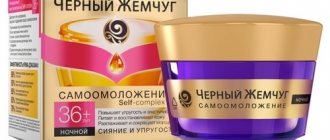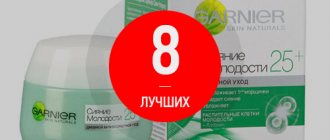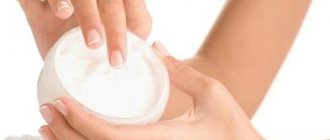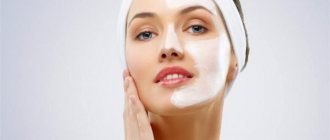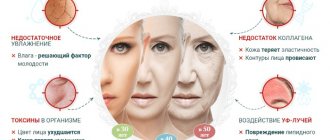Let's figure it out together with Tiina Orasmäe-Meder , cosmetologist, president of the Meder aesthetic cosmetology center, medical expert on cosmetic safety at the European Parliament.
How do moisturizers differ from nourishing products? Once upon a time, I would have considered such a question a manifestation of extreme “stupidity.” Of course, nutrition consists of vitamins and fats. Our skin especially lacks them in winter, with its frosts, icy winds and the dwindling supply of nutrients accumulated in the summer. Moisturizers primarily contain humectants. In the spring, when the skin, weakened during the winter, begins to peel off, become irritated, and crack, the main emphasis in care was on moisturizing. But today “everything is mixed up in the Danish kingdom.” Our grandmothers' fatty, dense creams have long been out of favor. Moisturizers contain the same vitamins and fats. And cosmetics manufacturers from time to time joyfully report on the emergence of “universal” creams that can independently “diagnose the problem” and where necessary - moisturize, where necessary - nourish, and at the same time fight excess sebum (oily sheen). Perhaps, indeed, such a division and the recommendations associated with it have lost their relevance?
“In fact, by and large, nothing has changed,” says Tiina Orasmäe-Meder. “In my opinion, there has been an even greater division between moisturizing and nourishing products. First of all, this is due to the emergence of low molecular weight application forms of hyaluronic acid. But here we need to clearly understand what goals we set for ourselves when choosing a means.”
Hydration
Moisturizers today solve two problems. The first is the introduction of moisture into the upper layers of the epidermis and the method of retaining it in these layers. The second is the introduction of moisturizing components into the deep layers of the epidermis and dermis and, again, enhancing the ability to retain it.
It is also very important to provide the skin with moisture from the inside, which depends on the activity of transdermal water exchange. To do this, cosmetologists advise drinking more fluids, introducing green tea into the diet (it is better absorbed biologically), and limiting the consumption of caffeine-containing products.
Moisturizing preparations today include:
- Film-forming agents based on artificial fats (vaseline) and natural origin (aloe juice extract, marine collagen). By creating a film on the surface of the skin, they prevent the evaporation of moisture from the epidermis. By and large, basic winter creams are also moisturizing.
- Preparations with substances capable of attracting and retaining moisture - based on glycerin, collagen, high molecular weight hyaluronic acid, also working at the level of the epidermis. They are especially needed in cases where the skin is injured (cold air, wind, sun, chlorinated pool water), and it urgently needs to be “closed.”
- Deep-acting cosmeceuticals containing low molecular weight ingredients of hyaluronic acid, Indian tamarind, Asian centella. They allow you to suppress the loss of water from the dermis and achieve a greater influx of water into the dermis.
- Cosmeceutical stimulating agents based on peptides. By overcoming the protective barrier of the skin, they stimulate the synthesis of their own hyaluronic acid in its deep layers. This group of products is aimed more at aging skin, which is already beginning to lose its natural moisture retention mechanisms.
What's new:
There is still a point of view that moisturizers should be used with great caution in winter. When you go outside, water can freeze to “crystals” and damage your skin. “This is a myth,” explains Tiina Orasmäe-Meder. — Yes, moisturizing creams contain a lot of water - up to 70-80%. But our skin is not a freezing organ. Its temperature, even with hypothermia, does not fall below 32 degrees. Getting into the skin, the water very quickly heats up to its temperature. Another thing is that regularly going out into the cold with a wet face can lead to dehydration.
Therefore, in winter, cosmetologists recommend using thicker products that help the skin retain moisture. Moisturizers can and should be applied, but the protective properties of creams in winter should be more pronounced. A good solution is to regularly use makeup that will help protect your skin.
Difference
Moisturizing:
- 70% consists of water.
- The main function is to prevent moisture loss.
- Becomes destructive at sub-zero temperatures.
- Suitable for any skin at any age.
Nutritious:
- 60% consists of vegetable fat.
- The main function is to nourish the face and hands with vitamins and minerals.
- Useful at sub-zero temperatures.
- Suitable for mature skin, contraindicated for young skin.
Nutrition
The main task of nutritional supplements is to compensate for lipid deficiency (lack of fat).
Which, indeed, we especially need in winter. By supporting lipid systems, they not only protect and nourish the skin, but also secure the natural moisturizing factor on its surface. That is, in winter we treat normal skin as skin with a tendency to dryness.
Nutrients today include:
- Preparations with fat-soluble vitamins, primarily D and E.
- Lipid-based preparations of varying degrees of availability. If previously lipids and fatty acids of synthetic origin (vaseline and lanolin) were mainly used in cosmetics, now they have been replaced by plant ingredients: for example, palmitic acid. They can exist both in the form of independent fatty compounds and in combination with peptides.
- Preparations with Omega 3, 6, 9 fatty acids. They not only strengthen the lipid layer, but also have a powerful antioxidant effect.
What's new:
If once upon a time nutritional products were heavy and dense, today cosmetic fashion has changed. Thanks to new technical capabilities, a large number of excellent microwaxes, lamellar emulsions, and microemulsions have appeared. They allow you to achieve a good nutritional effect without covering the skin with a fairly voluminous, dense film. Moreover, recent studies say: it is better to leave the upper layers of the epidermis free. The drug should seem to “fall” through them into the skin. This is due to the fact that it is the condition of the upper layers of the epidermis that the basement membrane reacts to. When they are “clogged” with a dense film, the membrane reduces activity and cell renewal slows down. The division of skin cells of a 30-35 year old woman increases from 24-28 days to 35-36 days. And this is the path to accelerated aging, hyperkeratosis and hyperpigmentation. On the contrary, when the upper layers are open, the cells divide according to their biological age.
Storage conditions and shelf life
Unopened creams are stored for about 3 years. Opened packaging should be used within a year. Under no circumstances should you use an expired product to avoid disastrous consequences. The best place for storage is a closed cabinet. Cosmetics prefer dry, cool conditions without exposure to sunlight. This helps preserve all useful microelements for a long time. Therefore, storage in the bathroom, as some women prefer, is not the best option. Under the influence of moisture and temperature changes, there is a high probability of bacteria appearing in the cream. On hot summer days, it is better to store the products in the refrigerator. Due to increased heat, cosmetic products can deteriorate much faster.
Why the confusion?
The mixing of nourishing and moisturizing preparations occurs because their functions often overlap, explains Tiina Orasmäe-Meder. - The same kernel oils - grape seed extract, cranberry, apricot - increase moisture retention in the skin. And to a certain extent they stimulate the synthesis of not only collagen and elastin, but also hyaluronic acid. On the other hand, Indian tamarind or low-molecular forms of hyaluronic acid, by stimulating fibroblasts, enhance not only the synthesis of “hyaluronic acid”, but also collagen and elastin, which at the same time puts them in the category of nutritional preparations. Any products that restore moisture retention in the upper layers of the skin help restore lipid fractions, giving a certain nutritional effect. Therefore, for myself, I divide nutrition and hydration according to the predominance of functions.
Preparations that work more to retain moisture and increase the volume of water in the epidermis and dermis are moisturizing. Preparations that include lipids that enhance their synthesis and prolong their life are nutritious.
By and large, purely moisturizing preparations are needed primarily for freshly injured skin: after chemical peels, dermabrasion, sunburn, chapping. And purely nutritional - for atopic dermatitis, neurodermatitis, psoriasis, in which there is a deficiency of cyramides and fatty acids. They must also be present in care after menopause, when lipid deficiency almost always occurs.
Such confusion, our expert believes, stems from the fact that many articles today are written by non-professionals. No matter what drug you start reading about, they always say the same thing: moisturizes, nourishes, softens the skin, reduces the number of wrinkles, they become less pronounced. Therefore, consumers do not understand what is meant.
Nutrients
Nourishing creams are designed to care for aging skin. They prevent the aging of the epidermis. They should not be used by young girls under 30 years of age.
These products effectively get rid of rough skin and pimples, and also restore the top layer of skin cells. They can also be used for medicinal purposes for oily and problematic epidermis.
Nourishing creams are used to protect the skin from frost and cold winds. In summer they are used to prevent the epidermis from drying out. These products are also recommended to be applied before bed, as the skin does not absorb nutrients well at night.
Skin nourishing creams are most often created on a vegetable oil basis. They have a thick consistency, reminiscent of sour cream.
“Universal” creams
But according to Tiina Orasmäe-Meder, information about universal “smart” creams that can “diagnose” the skin with the help of special liposomes and at the same time moisturize, nourish and fight oiliness should be treated with a certain degree of skepticism.
“I’ll tell you as a cosmetics manufacturer: we haven’t been able to put more than 5-6 ingredients into any of our products. The fewer ingredients the product contains, the higher the concentration of each, and, therefore, the better the effect. In addition, the ingredients, especially active peptide ones, are not very friendly with each other. And technically it is very difficult to imagine how the same cream can contain the necessary concentration of liposomes with nutrients that dry skin needs. And the necessary concentration of sebum-regulating components necessary for oily skin. And how can you make sebum regulators not work when they come into contact with the skin, if it is dry, how can you make liposomes select. I don’t yet know such mechanisms in cosmetic chemistry. This is a tempting idea. But for now its implementation is a matter of the future.”
How and when to apply
As a day care, the cream is applied in a thin layer 30 minutes before applying makeup. Use the product in the evening immediately after cleansing your face. Excess must be removed with a paper towel. The procedure is carried out half an hour before bedtime. On oily dermis, the product is applied with fingertips, using light, circular, lightly patting movements along the massage lines. The product should be applied to dry skin, gently smoothing without pressing on the face.
Read how to properly apply foundation on your face here.
Variety of brands
There are many brands of cosmetics that produce different types of care products. As a rule, each company has its own specifics and its own focus. For example, Nivea mostly produces nourishing products, and Vichy produces moisturizers with collagen, which prevents aging.
Dao de Mei brand has not only a moisturizing effect, but also a healing, rejuvenating, and antibacterial effect. TianDe natural cosmetics rejuvenate the skin and fill it with beneficial minerals of nature itself.
There are also products with additional moisturizing - for example, the French brand Yon-Ka .
conclusions
- In winter, the skin is at risk of dehydration and cold allergies, so care is needed that includes nutrition, protection, hydration, restoration, and normalization of all processes.
- Creams for the winter are a complex of oils, vitamins, polymers, moisturizing, restoring and stimulating substances (with a predominance of fats).
- For regular care, you should choose formulas taking into account your skin type, lifestyle, and tendency to allergic reactions.
- Complete care products are not necessarily expensive; among domestic brands you can find all the necessary creams and ointments at affordable prices. These include Winter Care cream.
- In winter, special attention is paid to aging skin, supplementing care with hormonal, regenerating, and rejuvenating supplements.
Which to choose
Moisturizing and nourishing are what our skin needs every day. Therefore, it is necessary to decide what the cream will be used for and at what time of year. You also need to take into account the characteristics of the skin, the composition of the product, the woman’s age and individual preferences.
What should be included
Comprehensive action is ensured by a set of mandatory components, each of which is responsible for its own area:
- vitamins A, D, C, E, F – nutrition, endurance;
- collagen, elastin, hyaluronic acid, hormones – elasticity, density, renewal, rejuvenation;
- microelements (magnesium, calcium, zinc) – active cell activity;
- oils, fats – protective shell, elasticity, smoothing;
- plant extracts - healing, softening effect, saturation with vitamins, moisture.
The composition of the Christina nourishing cream can be found here.

